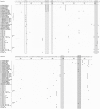Genetic variation in the HN and SH genes of mumps viruses: a comparison of strains from mumps cases with and without neurological symptoms
- PMID: 23637906
- PMCID: PMC3634820
- DOI: 10.1371/journal.pone.0061791
Genetic variation in the HN and SH genes of mumps viruses: a comparison of strains from mumps cases with and without neurological symptoms
Abstract
Background: It is known that mumps virus (MuV) strains may vary in their neurovirulent capacity, and certain MuV strains may be highly neurotropic. In animal models and epidemiological studies, mutations at specific amino acids (aa) have been proposed to be associated with neurovirulence. To assess whether these genetic variations can be observed in clinical samples from patients and if they correlate with neurovirulence as determined by clinical symptoms, 39 mumps patients with or without neurological symptoms were investigated.
Principal findings: Respiratory samples, oral fluids, throat swabs, and neurological and cerebrospinal fluid samples were tested by RT-PCR and products sequenced. Sequences of the entire small hydrophobic (SH) gene and the partial hemagglutinin-neuraminidase (HN) gene were compared.
Conclusions: The results showed there was no significant difference between the samples of the two groups of patients at the aa sites in either the HN protein or the SH protein, which have previously been hypothesized to be associated with neurovirulence or antigenicity. The occurrence of neurological symptoms of mumps does not appear to be due to a single point mutation in either the HN or SH gene.
Conflict of interest statement
Figures


References
-
- Hviid A, Rubin S, Muhlemann K (2008) Mumps. Lancet 371: 932–944. - PubMed
-
- World Health Organization (2012) Mumps virus nomenclature update: 2012. Weekly Epidemiological Record (WER) 87: 217–224. - PubMed
-
- Jin L, Rima B, Brown D, Örvell C, Tecle T, et al. (2005) Proposal for genetic characterisation of wild-type mumps strains: preliminary standardisation of the nomenclature. Arch Virol 150: 1903–1909. - PubMed
-
- Santos CL, Ishida MA, Foster PG, Sallum MA, Benega MA, et al. (2008) Detection of a new mumps virus genotype during parotitis epidemic of 2006–2007 in the state of Sao Paulo, Brazil. J Med Virol 80: 323–329. - PubMed
-
- Saito H, Takahashi Y, Harata S, Tanaka K, Sano T, et al. (1996) Isolation and characterization of mumps virus strains in a mumps outbreak with a high incidence of aseptic meningitis. Microbiol Immunol 40: 271–275. - PubMed
Publication types
MeSH terms
Substances
Associated data
- Actions
- Actions
- Actions
- Actions
- Actions
- Actions
- Actions
- Actions
- Actions
- Actions
- Actions
- Actions
- Actions
- Actions
- Actions
- Actions
- Actions
- Actions
- Actions
- Actions
- Actions
- Actions
- Actions
- Actions
- Actions
- Actions
- Actions
- Actions
- Actions
- Actions
- Actions
- Actions
- Actions
- Actions
- Actions
- Actions
- Actions
- Actions
- Actions
- Actions
- Actions
- Actions
- Actions
- Actions
- Actions
- Actions
- Actions
- Actions
- Actions
- Actions
- Actions
- Actions
- Actions
- Actions
- Actions
- Actions
- Actions
- Actions
- Actions
- Actions
LinkOut - more resources
Full Text Sources
Other Literature Sources
Medical

